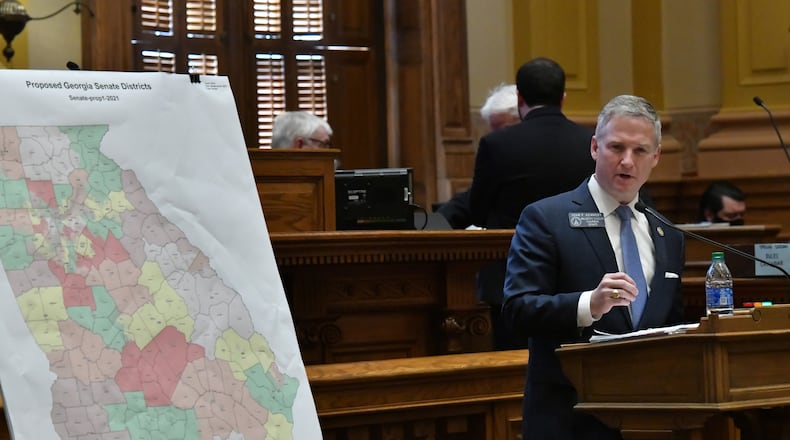A new political map of Georgia released Wednesday would help Republicans gain at least one seat in Congress, using redistricting to reverse Democratic gains and flip a district held by U.S. Rep. Lucy McBath.
The long-awaited map could increase Republicans’ 8-6 majority in Georgia’s congressional delegation by stretching a suburban Atlanta district into much more conservative areas to the north in Cherokee, Dawson and Forsyth counties.
The redistricting proposal arrives two weeks into a special legislative session, and the General Assembly’s Republican leadership plans rapid approval, solidifying their hold on Georgia’s delegation ahead of next year’s elections.
Georgia would become the latest state where the majority party is using its power to redraw congressional maps to gain seats in Washington. Redistricting in other states has already shifted five seats toward Republicans in the U.S. House, where Democrats currently hold a 221-213 advantage.
Because Republicans control both the Georgia House and Senate, they have enough votes to pass the congressional map over Democrats’ objections that representation should more closely reflect the state’s even split between the two political parties. Lawsuits asking the courts to invalidate the maps could soon follow.
During a Senate Redistricting Committee meeting held three hours after the proposal was released, Chairman John Kennedy, a Republican from Macon, said the new map is fair and addresses the loss of population in South Georgia that forced an “accordion effect of pushing the districts northward.”
The map threatens McBath’s reelection chances in Georgia’s 6th Congressional District that currently covers parts of Cobb, DeKalb and Fulton counties — a seat once held by Republican Newt Gingrich that McBath won in 2018.
McBath, who was reelected with 55% of the vote last year, would now face the difficult prospect of running for reelection in a district that leans distinctly Republican.
“Georgia Republicans, the NRA and the Republican Party have made eliminating Lucy McBath from Congress their top priority, and they are attempting to do so in a remarkably undemocratic process,” said her campaign manager, Jake Orvis. “It is disappointing to see Republicans in the state legislature attempt to suppress the hundreds of thousands of voters represented by Rep. McBath.”
Credit: Special
Credit: Special
McBath could instead run in a Democratic primary against U.S. Rep. Carolyn Bourdeaux for Georgia’s 7th Congressional District, which would become more solidly liberal under the redistricting proposal. Bourdeaux’s election victory last year flipped that seat to the Democratic Party.
Cindy Battles of the Georgia Coalition for the People’s Agenda, a civil rights organization, said by putting large blocks of nonwhite voters into the 7th District, Republican map-drawers compacted the voting power of people of color.
“Georgia’s long and documented history of racial discrimination continues to be present in this map for the next decade,” Battles said. “You guys owe the people of Georgia something better.”
Credit: Isaac Sabetai
Credit: Isaac Sabetai
Unlike his Republican colleagues who’ve repeatedly invoked 2001′s eventually thrown-out maps drawn under Democratic control, state Sen. Bill Cowsert said he’d rather talk about the 2011 maps drawn after the GOP took control of the Legislature.
“We rose above that, adopted these principles that respect county boundaries, that respect communities of interest, that have equal sized districts, that are compact,” the Athens Republican said. “And we’re committed to doing that again this time.”
House Speaker David Ralston, a Republican from Blue Ridge, said the new map is “thorough, transparent and inclusive.”
“Today, we have released a proposed map that reflects Georgia’s growing, diverse population, respects jurisdictional lines and communities of interest, and conforms to applicable legal standards including the Voting Rights Act,” Ralston said.
The Republican-drawn map released Wednesday is similar to a previous proposal made public by the state Senate GOP in September. However, the latest map makes the 6th District even more conservative.
Ken Lawler, chairman of the nonprofit Fair Districts GA, an advocacy group seeking fair and transparent redistricting, said the maps proposed Wednesday create no competitive districts, with a margin between the political parties of plus or minus 3.5 percentage points.
“It looks to us like there are more packed Democratic districts, (and) they’re much more extensively packed than they need to be,” Lawler said. “And that, obviously, is affecting the outcome of the map. Whereas the Republican voters are much more efficiently distributed from an election point of view. So Republican voters get more mileage out of the votes than the Democrats in this map.”
The 2nd District in southwest Georgia, held by Democratic U.S. Rep. Sanford Bishop, would become slightly more competitive. The proposal reduces the district’s Black population to 49%, down from its current 51% Black population.
Bishop said Wednesday he’s “absolutely” running for reelection and will make a strong case to voters, with 28 years in Congress and consistent support for the state’s military bases, ports and other industries.
“The people know who I am, they know what I stand for and they know that I’ve delivered,” Bishop said.
In another change, the conservative northwest Georgia district held by Republican U.S. Rep. Marjorie Taylor Greene would extend into parts of Cobb County in metro Atlanta, including Austell and Powder Springs. Still, the 14th District would remain solidly Republican.
The redistricting proposal is on a fast track toward approval after the General Assembly already passed maps for the state House and Senate. The state legislative maps would safeguard Republican majorities but create a handful of new Democratic-leaning districts because of population increases primarily in the metro Atlanta area.
Redistricting is required every 10 years to ensure that districts have the same populations following the census. Georgia’s population increased by 1 million over the last decade to a total of 10.7 million, but the growth wasn’t large enough to net the state an additional seat in Congress.
Each of Georgia’s 14 congressional districts will represent about 765,000 residents. Senate Democrats plan to present their version of congressional maps during a Thursday hearing.
After passing the House and Senate, the redistricting plan will head to Republican Gov. Brian Kemp for his signature.
— Staff writer Tia Mitchell contributed to this article.
Keep Reading
The Latest
Featured






